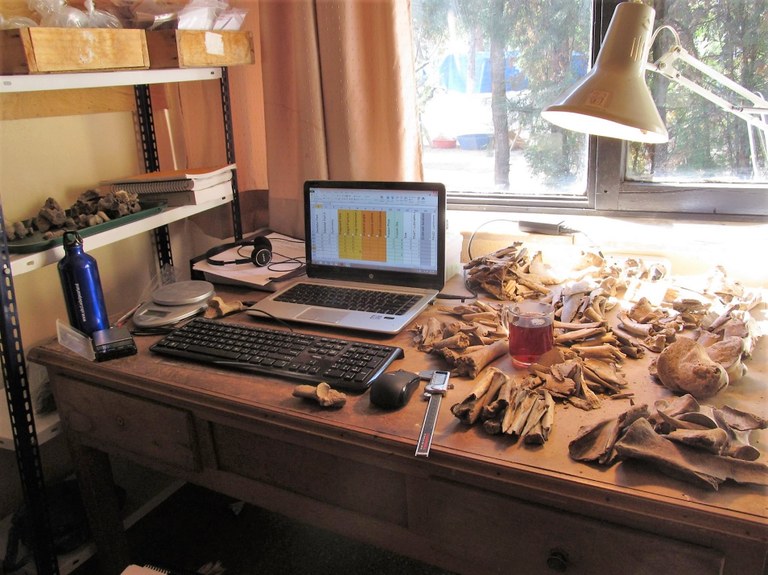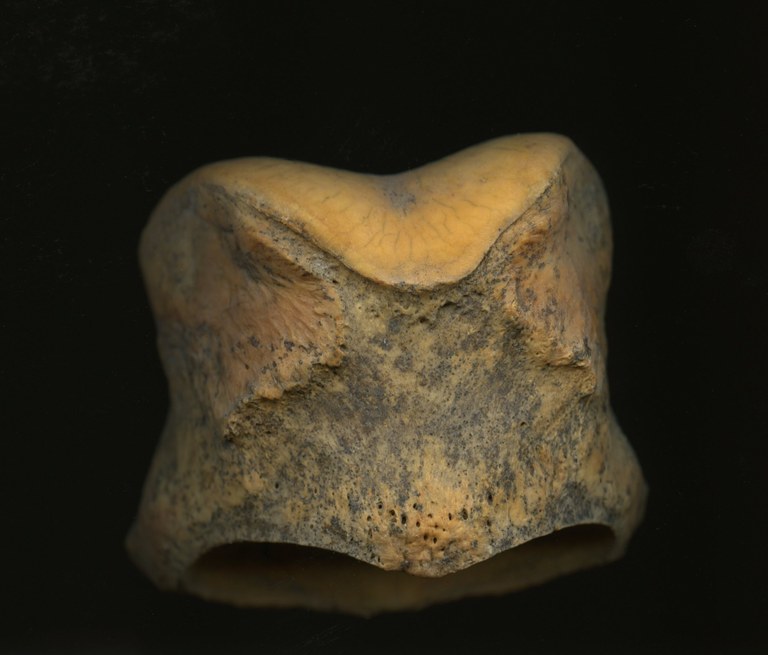Research
Domestication has been a key area of study for archaeologists working in the ancient world for decades, reaching back to the first multi-disciplinary, scientific excavations at Jarmo in modern Iraq in the 1940s and 1950s and to Childe’s (1950) theory of urban revolution. Since then, we have learned sheep and goat domestication began in the Fertile Crescent around 11,000 years ago (Zeder 2008), and that plant and animal domestication occurred independently in at least eleven different areas in the Old and New Worlds (Larson et al. 2014). At the same time, there is still much we don’t know, both in terms of the “whens” and “wheres” of domestication and regarding our understanding of domestication as a complex and varied social and biological process.
 Author's desk at the Hattuşa dig house, Turkey
Recently, through my research on Bronze and Iron Age animal remains in central Anatolia (present-day Turkey), I was able to collaborate with an international group of archaeologists and paleo-geneticists to help address one such gap in our knowledge of domestication (Guimares et. al 2020). Our goal was to better understand horse domestication through a paleogenetic study of equid remains from fourteen sites in Anatolia and the Caucuses dating from the early Neolithic period through the Iron Age (ca. 9000 to 500 BCE). Given the long history of wild horse exploitation in the region, Anatolia has been hypothesized as a possible center for horse domestication, but scientific examinations of this possibility have been extremely limited. Instead, the search for the ancestors of the modern domestic horse has tended to focus on the Central Asian steppe and the Pontic-Caspian steppe.
Author's desk at the Hattuşa dig house, Turkey
Recently, through my research on Bronze and Iron Age animal remains in central Anatolia (present-day Turkey), I was able to collaborate with an international group of archaeologists and paleo-geneticists to help address one such gap in our knowledge of domestication (Guimares et. al 2020). Our goal was to better understand horse domestication through a paleogenetic study of equid remains from fourteen sites in Anatolia and the Caucuses dating from the early Neolithic period through the Iron Age (ca. 9000 to 500 BCE). Given the long history of wild horse exploitation in the region, Anatolia has been hypothesized as a possible center for horse domestication, but scientific examinations of this possibility have been extremely limited. Instead, the search for the ancestors of the modern domestic horse has tended to focus on the Central Asian steppe and the Pontic-Caspian steppe.
 Equid phalanx from the Bronze Age site of Acemhöyük in central Anatolia, which was sequenced for the paper.
Equid phalanx from the Bronze Age site of Acemhöyük in central Anatolia, which was sequenced for the paper.
Based on current genetic research, it is widely thought that horses were domesticated between 4000 to 3000 BCE. However, the genetic patterns revealed by our analysis show that domestic horses appeared in Anatolia around 2000 BCE and that their appearance was sudden rather than gradual. These results suggest that domestic horses were imported into the region during the Bronze Age, perhaps via the Caucuses, and that Anatolia was not an independent center of horse domestication. Instead, there was a nearly total population shift in the horse population in Anatolia dating to the Bronze Age and afterward, which aligns well with the appearance of horse management in Anatolia and Mesopotamia as documented by textual and iconographic sources.
If you’d like to learn more, you can access the article here.
Childe, V. Gordon. 1950. “The Urban Revolution.” The Town Planning Review 21(1): 3-17.
Guimaraes, Silvia, Benjamin S. Arbuckle, Joris Peters, Sarah E. Adcock, Hijlke Buitenhuis, Hannah Chazin, Ninna Manaseryan, Hans-Peter Uerpmann, Thierry Grange, & Eva-Maria Geigl. 2020. “Ancient DNA Shows Domestic Horses Were Introduced in the Caucasus and Anatolia during the Bronze Age.” Science Advances 6(38): eabb0030. DOI: 10.1126/sciadv.abb0030
Larson, Greger, et al. 2014. “Current Perspectives and the Future of Domestication Studies.” PNAS April 2014, 111(17): 6139-6146. DOI: 10.1073/pnas.1323964111
Zeder, Melinda A. 2008. “Domestication and Early Agriculture in the Mediterranean Basin: Origins, Diffusion, and Impact.” PNAS August 2008. DOI: 10.1073/pnas.0801317105